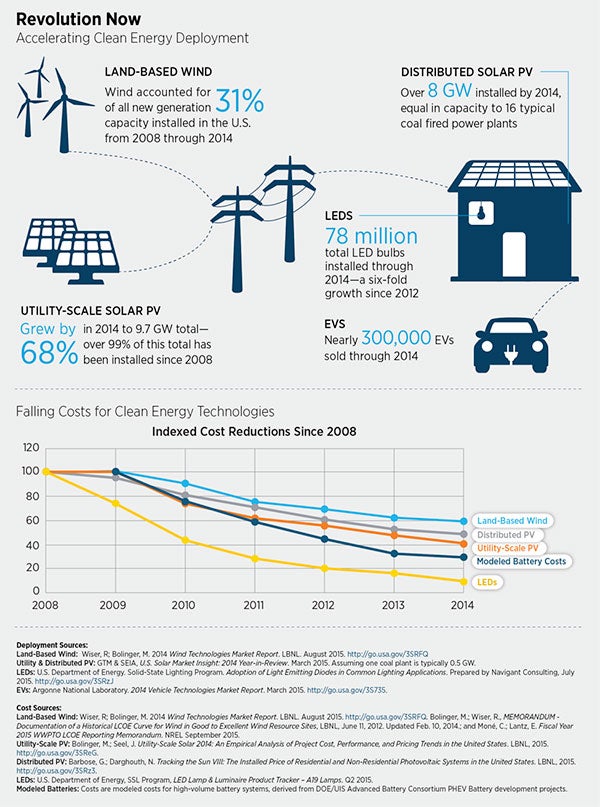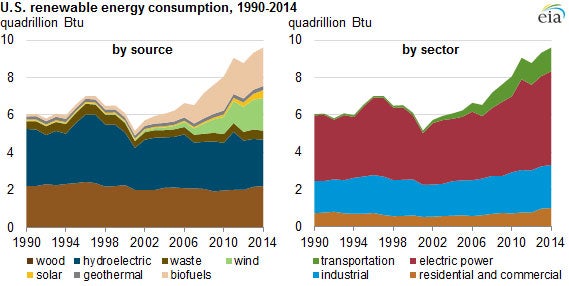U.S. buildings have grown colder in recent years. The switch from the heat-generating incandescent bulbs to light-emitting diodes, or LEDs, reduces the energy used to produce light by as much as 85 percent.
The cost of LED bulbs has dropped by over 90 percent in recent years, explains David Friedman, principal deputy assistant secretary for the Office of Energy Efficiency and Renewable Energy at the U.S. Department of Energy (DoE). "Ultimately, over the next five to 10 years, it will cut the electricity use of lighting in half."
LEDs are just one of the technologies at the forefront of a clean revolution sweeping the U.S. The solid-state light sources have grown from 400,000 installations in 2009 to some 78 million in 2014, according to the DoE's latest analysis of the fastest growing clean-energy technologies—and LEDs are not alone. Wind, solar and other technologies have seen similar explosive growth, providing a glimmer of hope that the world might be able to combat climate change this century. National commitments made under the auspices of climate negotiations in Paris could further drive the adoption of clean-energy technologies, not just in the U.S. but in the European Union as well as China, who has already begun investing in clean technologies and whose president last year set a joint goal with Pres. Barack Obama to stop greenhouse gas pollution growth by 2030.
On supporting science journalism
If you're enjoying this article, consider supporting our award-winning journalism by subscribing. By purchasing a subscription you are helping to ensure the future of impactful stories about the discoveries and ideas shaping our world today.
"We will look back on this time as one where rapid acceleration of deployment of clean-energy technologies," says Lynn Orr, DoE undersecretary for Science and Energy. "That's not an accident. "In fact, the Obama administration has helped jump-start this nationally via programs that have made loans to build large solar-power plants as well as invested in research and development through agencies like the Advanced Research Projects Agency–Energy. As a result, just as there has been a great acceleration in everything from human population to the amount of carbon dioxide piling up in the atmosphere over the course of the 20th century, the early decades of the this century may be witnessing a great acceleration in the deployment of clean-energy technologies.

Courtesy of DOE
For renewables, the key seems to be to think small. Whether LEDs or photovoltaic (PV) panels, part of the cost reduction results simply from the fact that so many millions of such small devices have been built. Similarly, tens of thousands of wind turbines have sprung up across the continent and now constitute more than 4 percent of all U.S. electricity generation, saving both carbon dioxide pollution from burning fossil fuels as well as the water needed to cool power plants based on heat. Additionally, electric vehicles (EVs) have begun to appear on roadways, thanks to refueling costs that work out to as little as a $1-per-gallon equivalent and cost reductions from making millions of lithium ion batteries. "Those are little rockets," Orr notes. "Some fraction of us will buy these just for fun."
Bigger-scale low-carbon technologies—such as carbon capture to clean up fossil fuel–fired power or nuclear reactors—have not seen such explosive growth, in part due to the massive building costs. "We might be marching down the same learning curve, we just haven't marched as far," Orr says. And not all renewables have prospered. For example, harvesting the heat underground to generate electricity has not grown fast outside of Nevada.
Still, the U.S. now consumes more energy from renewable resources—nearly 10 percent in 2014—than at any time since the 1930s, when burning wood still heated most homes.

There is hope the trend may continue: Even as PV module prices have remained relatively stable in recent years, the cost of installing solar, including the necessary permits, has continued to fall. As a result, solar home leasing companies like SolarCity have had to get into manufacturing to ensure a steady supply of photovoltaic panels to feed their main business of putting solar on rooftops. "I'm trying to figure out how to advance sustainable energy as quickly as possible," explained solar and EV entrepreneur Elon Musk at a SolarCity event in October, who also plans to apply his EV battery expertise to the solar home industry. "In the long term the sun doesn't shine at night and winds are intermittent so you have to have storage to have a fully sustainable future."
Ultimately, "to cut greenhouse gases 80 percent by 2050 and dramatically reduce oil imports, the scale is so big we need all of these technologies," Friedman says. After all, the U.S. still gets more than 80 percent of its energy needs from fossil fuels—whether by burning coal or natural gas to generate electricity or refining oil into fuels to move cars or trucks. The planetary report card on efforts to cut back CO2—the Keeling curve that just hit 400 parts per million again, most likely permanently—continues to record failure to curtail fossil fuel–burning and its attendant pollution.
It's not just the U.S. A recent analysis by researchers at Massachusetts Institute of Technology and Tsinghua University suggest such commitments from the E.U. and other nations like China could drive further cost reductions in wind and solar as well as installations. And all of this U.S. action fits comfortably within recommendations by the U.N. Framework Convention on Climate Change's plans for how to restrain global warming, which even singles out the DoE's SunShot initiative to lower the cost of solar power as an example of climate action happening now.
The DoE sees hope to move the needle further on that challenge via developing technologies such as increasing the fuel efficiency of long-haul trucks as well as cars via aerodynamics or weight reduction. But cheaper fuel and expanded efficiency often mean that people drive more, the so-called rebound effect.
It remains to be seen whether the use of LEDs means a further profusion of light like Times Square as cheap lumens proliferate—like what happened during the 20th century after Thomas Edison's invention. And the extra energy used to heat cooler buildings may consume some of the enhanced energy efficiency of lighting. Light pollution may be one way to track energy waste going forward, as heat was in the past.
Even as clean energy accelerates, more than 60 percent of sockets in the U.S. still contain older lightbulbs rather than LEDs. As more LEDs are installed, other new technologies such as smart building sensors that turn lights on and off as people enter and leave rooms may help ameliorate any rebound effect. That will, in turn, further accelerate the clean-energy shift that just might give impetus to the fight to slow global warming. "Energy is woven so thoroughly through modern society and economies," Orr says, "that those who do an efficient, clean job of supplying the needs of their people will definitely be in a better competitive position."